Have you ever had a foster kitten or better yet, foster kittens, that’s right, kitten with an ‘s’? Fostering is such a  rewarding experience and we’d like to share our top 12 tips to raising friendly foster kittens.
rewarding experience and we’d like to share our top 12 tips to raising friendly foster kittens.
If you didn’t know, spring and early summer are two peak times that animal shelters and rescues get inundated with cats, female cats, pregnant cats and kittens. Most animal shelters and rescues would welcome volunteers to help them, whether that’s actually bringing a cat family into your home or just volunteering to clean cages, feed, water and socialize the cats. However, fostering is always needed so read the list below and get ready to love on some kittens!
12 Steps to Raise Friendly Foster Kittens
1- Calm Transport. If you’re transporting a new foster kitten from a shelter or rescue to your home, try to keep her calm in a carrier. Place something soft inside like a small blanket so she’ll be comfy. Place a blanket or towel over the outside so you don’t stress her out with the movement unless it’s really warm, in that case, turn on the air if you have it.
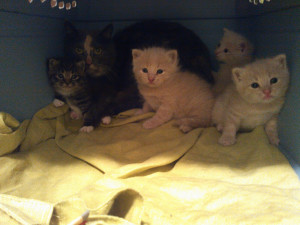
2- Safe Surroundings. Whatever room you’ve set up to keep the foster kitten in should be free from dangerous chemicals or items that could hurt the kitty if they she were to climb on or get in. Ideally the walls to the room should be solid and not have any holes in the drywall or open windows. FYI: You might find it silly to think about this but believe me, people have been known to foster kittens in the most unsafe situations and accidents HAVE happened. If you’re keeping the momma and/or kittens in a crate, make sure the crate is large enough for a cat box, ample free floor space so they can walk around and make sure it’s secure and safe so kittens can stay contained. Be sure to let the kittens out of the crate multiple times during the day as they start getting bigger. Free time will help them learn to get used to new surroundings and allow them to play better than they can in the crate.
Note: If you’re leaving your momma and kittens in a room by themselves it’s a good idea to place them in the room with the crate/carrier door open and leave them be for a few hours. When they decompress they’ll come out and start investigating.
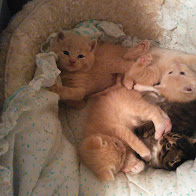
3- Age-Appropriate Food. Depending on the age of your foster kitten and if the momma is with her, you might need to bottle feed. Go to your local pet supply store and ask them about kitten milk replacer and buy the necessary supplies (syringe, eye dropper or bottle) then move on to other kitten food as she gets older. It’s important to feed the right food at the right stages for proper kitty development. Kittens can’t eat large pieces of cat food until their teeth are developed nor does the food have all the nutrients, vitamins and minerals they’ll need at that age. Kitten food is a necessity.
The right kind of bowl is important as well. Most cats don’t like their whiskers to touch the sides of the bowl when they eat, especially if they’re eating canned cat food. Shallow dishes and even small plates are good to place wet/canned cat food on. Be sure to clean these after each feeding.
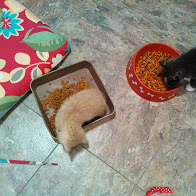
4- Clean Water. Your foster kittens need fresh water in a shallow bowl or dish. We urge you to not use deep bowls because the babies can fall in them and drown. You’ll need to change their water frequently because they will drop food particles in it and cat litter always makes its way into the water bowl. Place the water bowl on something that can absorb any spills.
5- Litter Boxes Sized Right. In a shelter environment, the cat cages are usually small so a large litter box is rare. While at your home, purchase a larger litter box so they’ll have plenty of room. Kitties like to potty with their siblings so it’s not uncommon to have 2 or 3 kittens in the litter box at the same time. Kittens need litter pans that are lower so they can get in easily and they might not be able to climb over taller sided litter boxes. Additionally, we recommend having two litter boxes in the room, one larger for mom, one smaller for babies. As the kittens grow, you can just purchase a larger litter box and put the smaller one aside. Also, keeping these litter boxes clean is important – we suggest you scoop the boxes several times each day. Your kittens will play in these boxes and will get in and hide from his siblings so keeping the waste cleaned regularly is important.
Speaking of cat litter, we suggest you use the highest quality cat litter possible when the kittens are small. Their respiratory systems are delicate and many of the litters on the market are known for dispelling lots of dust as they scratch. We’re using scoopable Tidy Cat litter currently.
In the picture below, Therapy Dog Sonny, watches on as this foster kitten does his business. Sonny likes to clean the babies and sleep with them on occasion. He’s always monitored when he’s around the little ones and he’s become a huge asset in helping me socialize the kittens to dogs and ‘new things’. We call him ‘The Kitten Whisperer’.
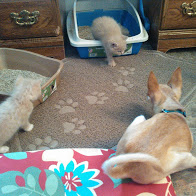
6- Safe Touch. Depending on how the foster kittens were obtained, they could be from a feral or semi-feral momma cat or could be the friendliest kitty’s around. If the momma cat is shy, has huge pupils when you get near her, crouches down or runs and hides from you, she’s probably not used to humans being nice to her. Her kittens will likely follow in her footsteps unless you step in. Feral cats can be hard to adopt so take the time to really work with them now.
What I’ve found that works is to just sit on the floor and to just let the kittens explore when they’re ready. You can use canned cat food to lure mom to you. Take a spoon and put a small amount on it, put it near her nose and just go sit down. She’ll likely come over to grab a treat! I use a light touch at first then begin handling them once they relax.
Ferals and semi-feral foster kittens require a ton of patience and might not ever seek human attention. However, providing a calm human presence is important at this stage so she does learn that some humans aren’t scary. Be sure to pick the kittens up, cuddle them, kiss and nuzzle them. Get them used to being handled in odd ways too., like a baby or up on your shoulder for short periods of time. This helps get them used to being handled like children might.
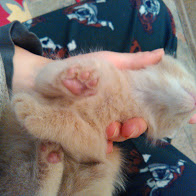
7- Various Sounds. Place a radio or tv in their room to help introduce the foster kitten to various sounds. This also increases their exposure to something other than your voice. When I’m visiting the foster kittens, I’ll use my baby talk voice and talk softly to them. I’ll also raise my voice once in a while. In my experience, the kittens and mom spook and hide when I do this so it’s important to immediately coax them back to you for some fun play. In the shelter environment, they’d likely be exposed to dogs barking, cats meowing and dozens of people coming and going on a daily basis. You can replicate this by doing the things mentioned above.
8- Light Stimulation. If you have a window in the room, open the curtain and let the sun in so the momma and kittens can look outside. After a few weeks of being cooped up in the room, the momma cat will start getting antsy more than likely. Also with light stimulation I like to come in when it’s dark and turn the light on and off. I talk softly to them while doing this so they associate that with me coming in to visit. The kittens will probably get scared when you do this but comforting them and rewarding them when they walk back over to you is important.
9- Fun Toys. As the foster kittens grow, they’ll need toys to stimulate them. Toys with feather and bells work great and strings are a big hit once the kittens get to the point where they chase things. Put a small blanket on the floor they can roll around on and hide in. As they grow, provide things they can climb on, i.e. cat towers, scratching posts. Make sure any toys you give them do not have strings or ribbons because these can be chewed off and cause intestinal blockages. Also, keep track of how many, and what type, of toys you have in their area so you’ll know if any come up ‘missing’.
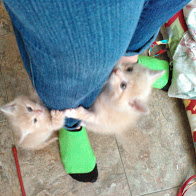
10- Cool Hiding Places. Provide empty boxes the kittens can jump on, run and hide in. Set things up in the room where they can play hide and seek. Make sure all furniture in the room is sturdy and can’t fall over on them.
11- Positive Socialization. Socialization starts with you. You should be the best, kindest, most loving person in her life and introduce your foster kitten to other people who will be gentle and loving to her. If you have sibling kitties and have to keep your kittens in a crate/carrier/partitioned off from the rest of the house, take them out of their area frequently for short periods of time so they can explore a little. Just be sure that you keep your eye on them AT ALL TIMES because they could run and hide somewhere or accidentally run outside if someone opens a door. If you have other pets, especially dogs, do slow introductions. And please don’t introduce kittens to dogs that have high prey drive – that could be a disaster! Hold the kitten and let your dog smell but don’t put your kitten on the floor. Your dog could accidentally step on him or quickly bite and you might not have time to react. CAUTION: If you have a dog that has injured cats or small animals before, DO NOT introduce this dog to the foster kittens. Keep the kittens safe at all times.
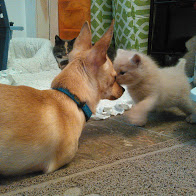
In the picture above, the kittens were introduced to Sonny first because I knew he’d be gentle with them. He’s been a great playmate the last couple of weeks and the kittens all flock to play when he comes to visit.
12- Nail Trims and Regular Veterinarian Check-ups and Vaccinations. A veterinarian check-up is important to make sure they’re healthy and progressing nicely. It’s best to start nail trims as soon as you’re able. Getting the kittens used to being handled for this simple procedure is easy to do when they’re small. Ask the veterinarian to do it and show you how so you can keep us with them.
Once they’re old enough, they’ll receive first round of vaccinations and an appointment to be spayed or neutered should be made before your kittens are adopted out. Before you take the kittens to the veterinarian, keep an eye on their ‘nose, eyes, ears and rears’. Any crustiness or drainage in either the nose or eyes should be checked by a vet. Simple eye ointment or antibiotics might be prescribed. Momma usually keeps their rears clean, however, some new moms don’t have this instinct and you’ll have to help babies potty. Doing this is easy, just take a warm wash cloth and gently rub their rear end. You’ll notice them start to potty. Lift up the tail and show it to mom. Hopefully she’ll start to clean but if not, just keep doing this a few times a day and she’ll get the hang of it. Once they start having bowel movements, you’ll need to check their bottoms frequently. Be gentle if you need to clean dried poo, use a warm rag and softly loosen the stool and show to mom – again, hopefully she’ll take over!
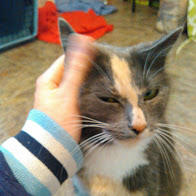
Spay Or Neuter Your Foster Kitten Before Adoption if Possible
In closing, we like to urge people to spay or neuter their foster kittens BEFORE they’re placed in a new home. Doing this early prevents unwanted litters, keeps them healthier and allows them to be better inside kitties (less marking, spraying and fewer tendencies to roam outside).
We recommend you take pictures of your foster kittens throughout their time with you. This helps people to see their personalities, shows how lovable they are and entices people to adopt. These pictures can be used for networking to help find them new homes. Minimize flash pictures because the bright light can injure kitten eyes.
If you aren’t fostering for a shelter or rescue and are doing it on your own, we suggest you never give away the kittens for free. Always ask for an adoption fee and if possible do a home check and get referrals from their friends and veterinarian. If you know this person hasn’t taken good care of their pets in the past, please don’t adopt to them. If you see this person on facebook begging for free animals, don’t adopt to them either.
A kitten is a big commitment but the love you receive far outweighs the scratches and constant cleaning. Being owned by a cat is one of the greatest pleasures I’ve had in life. Remember, fostering is very important because you’re helping that kitten grow into a fantastic, lovable, outgoing and friendly baby for someone to spend their life with.
Lastly, should you need a cat sitter or pet sitter, in the Muncie, Yorktown, New Castle or Anderson, Indiana area, call us, we’d love to help. We’re professional pet sitters and love kitties!
Enjoy Your Foster Experience,
Kelley Stewart, CEO|Pet Sitter
sit-stay-play In-home pet sitting & more.LLC
“Your pet sitting, dog walking, poop scooping specialists!”
P.S. If you have questions about fostering please call us at 765-744-5688.
P.P.S. If you need a pet sitter or cat sitter and have foster pets, we have a foster program discount. Ask us about it!
